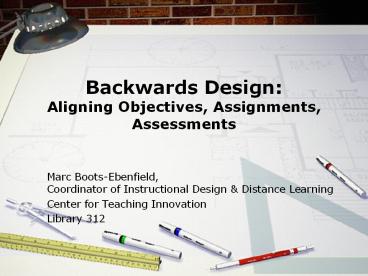Backwards Design: Aligning Objectives, Assignments, Assessments - PowerPoint PPT Presentation
Title:
Backwards Design: Aligning Objectives, Assignments, Assessments
Description:
Aligning Objectives, Assignments, Assessments Marc Boots-Ebenfield, Coordinator of Instructional Design & Distance Learning Center for Teaching Innovation – PowerPoint PPT presentation
Number of Views:87
Avg rating:3.0/5.0
Title: Backwards Design: Aligning Objectives, Assignments, Assessments
1
Backwards DesignAligning Objectives,
Assignments, Assessments
- Marc Boots-Ebenfield, Coordinator of
Instructional Design Distance Learning - Center for Teaching Innovation
- Library 312
2
Backward Design
- Goals Abstract
- Objectives Measurable
- Summative Assessment
- Activities / Assignments
- Content / Material
instructional strategy
3
4 Questions
- What are the goals of your course?
- What do you want students to be able to do at the
end of your course? - What are the core principles of your course?
- Describe your summative assessment.
4
Degrees of Understanding
- Know undefined depth of understanding
- Know passing familiarity
- Understand some grasp of material (can relate
information in own words) - Be able to do essential content /
understanding. Apply, evaluate, adapt
5
Learning What?
- A statement of a specific, measurable learning
outcome. In other words what will the student
be able to do as a result of the lesson?
6
Multiple Purposes
- Learning objectives are used to guide the
attention of the learner toward critical learning
messages. - Learning objectives are used to tell the learner
what's in the course. - They are used by instructional designers to guide
the design of the learning. - They are used by evaluation designers to develop
metrics and assessments.
http//www.willatworklearning.com/2006/06/new_taxo
nomy_fo.html
7
Multiple Forms
- Pushkin
- demonstrate close reading of text by citing and
reacting to specific passages - define themes based on patterns identified
through close readings - explain the place of the poet in Russian society
at this time period based on the persona
exemplified in Pushkins poems - explain the role of literature in Russian society
at this time period based on the themes
exemplified in Pushkins poems - demonstrate deep knowledge of Pushkins poetry
through well-crafted journal entries as judged by
the journal rubric
8
Multiple Forms
- Who was Pushkin (1799-1837)
- When did he write?
- Who did he write for? Who was the Russian
reading audience? - Where does this work fit in his oeuvre?
- Where does Pushkin fit in the development of
Russian literature? - What was going on in Russian at the time this
poem was written? - Who did Pushkin read- what we his literary
influences?
9
GOAL Make better citizens
Objectives
Describe local political events explaining the issues being discussed as they effect the individual and the state
Describe 5 key events in history of local politics (last 50 years)
List 4 ways to contact local representatives
Explain differences between major political parties on 4 key local issues
10
GOAL Write a publishable short story
Objectives
Students will write a short story containing a
well developed conflict and resolution as
described in the course. Scenes will contain
specific, concrete details and polished
transitions.
11
Culminating Project
Create the framework for an online course in
WebCT including one complete unit that follows
the best practices of online learning and course
design.
Course on Distance Learning
12
Objectives
- The WebCT environment will provide participants
with a sense of place through clear structure,
and navigation - You will welcome participants to your course by
using best practices for establishing closeness
and trust in an online environment - Course design will facilitate interactivity based
on research and best practices - The framework will reflect instructional design
principles such as - big ideas
- focus on performance goals
- clear learning objectives
- student-centered learning
- frequent, meaningful feedback including
self-assessment - You will evaluate your own course using a rubric
for excellence in online course design
13
Analysis of Subcomponents
- Course design will facilitate interactivity based
on research and best practices - Explain meaning of interactivity and types of
interactivity - Define characteristics of interactivity in
online environment (synchronous, two-way,
initiator, level engagement) - Describe design factors (architecture) that
influence interactivity - Differentiate interactions that increase course
satisfaction and/or improve learning - Create interactions reflective of best practices
in course design
14
Backward Design
- Goals Abstract
- Objectives Measurable
- Summative Assessment
- Activities / Assignments
- Content / Material
instructional strategy
15
ObjectivesActivitiesAssessments
Unit 5 Interactivity
1) Objective explain meaning of interactivity and types of interactivity
1)Quiz/Assignment Interactivity- definition and types
2) Objective define characteristics of interactivity in online environment
2) Activity Use the grid provided to find and describe interactions in our online course.
3) Objective Describe design factors (architecture) that influence interactivity
3) Activity Each group has been assigned a section of WebCT to critique. How could your section be improved based on (content).
4) Objective Differentiate interactions that increase course satisfaction and/or improve learning
4) Activity Create a rubric for evaluating interactivity in an online course.
16
ObjectivesActivitiesAssessments
17
Backward Design
- Goals Abstract
- Objectives Measurable
- Summative Assessment
- Activities / Assignments
- Content / Material
instructional strategy
18
Unit 5 Interactivity
Content Taxonomy of interactivity in learning management systems
Quiz Interactivity- definition and types
Activity Use the grid provided to find and describe interactions in our online course.
Content design factors that influence interactivity
Activity Each group has been assigned a section of webct to critique. How could your section be improved to increase interactivity?
Content interactions that increase satisfaction
Content interactions that improve learning
Activity Create a rubric for evaluating interactivity in an online course.
19
Integration of Course Components
Goals
Objectives
Class Activities
Assessments
Assignments
20
(No Transcript)
21
References
- Wiggins, G. McTighe, J. (1998). Understanding
by Design. Alexandria, VA. ASCD. - Blooms Taxonomy http//www.nwlink.com/donclark/
hrd/bloom.html































